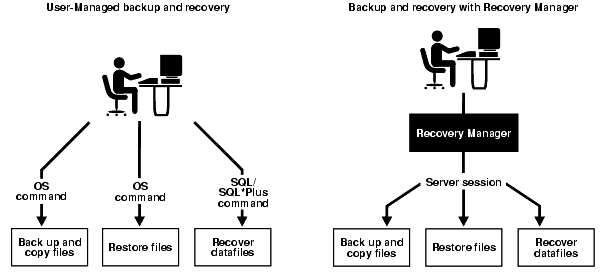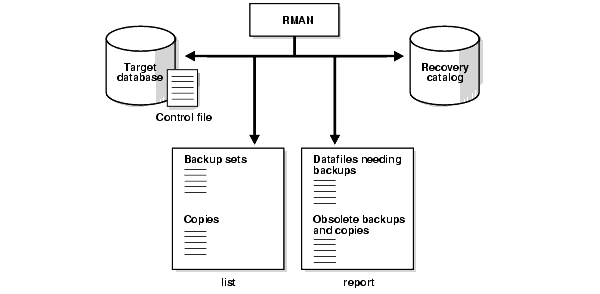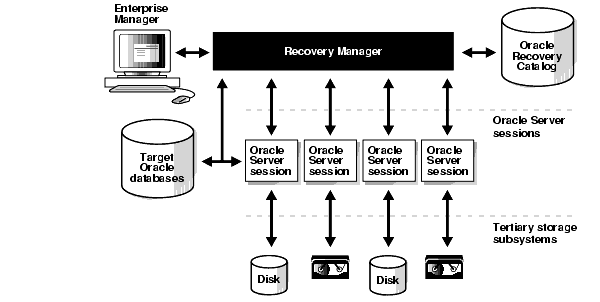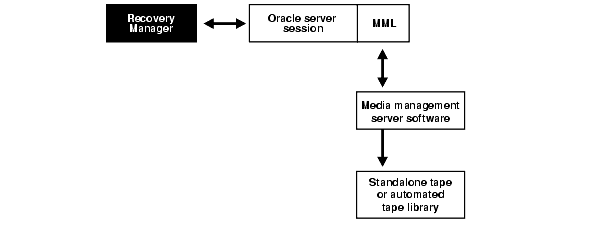Release 2 (9.2)
Part Number A96566-01
Home |
Book List |
Contents |
Index |
 Master Index |
 Feedback |
| Oracle9i Recovery Manager User's Guide Release 2 (9.2) Part Number A96566-01 |
|
This chapter describes the definition and advantages of the Recovery Manager (RMAN) utility.
This chapter contains these sections:
Recovery Manager (RMAN) is an Oracle utility that can back up, restore, and recover database files. The product is a feature of the Oracle database server and does not require separate installation.
Recovery Manager is a client/server application that uses database server sessions to perform backup and recovery. It stores metadata about its operations in the control file of the target database and, optionally, in a recovery catalog schema in an Oracle database.
You can invoke RMAN as a command-line executable from the operating system prompt or use some RMAN features through the Enterprise Manager GUI.
Most production database systems impose stringent requirements on backup and recovery. As a DBA in charge of backup and recovery, you must:
You have two basic methods for performing these backup and recovery tasks on an Oracle release 8.0 or higher database:
Why use one method rather than the other? As illustrated in Figure 1-1, RMAN uses server sessions to perform backup and recovery operations and stores metadata in a repository. RMAN automates backup and recovery, whereas the user-managed method requires you to keep track of all database files and backups. For example, instead of requiring you to locate backups for each datafile, copy them to the correct place using operating system commands, and choose which logs to apply, RMAN manages these tasks automatically.
The advantage of using RMAN is especially true if you use Oracle Managed Files. When you let Oracle name and manage your datafiles, control files, and online redo logs, the system becomes easier to use. On the other hand, it may be harder for you to keep track of the filenames of the various database files because you have not named them yourself. RMAN users do not suffer from this problem because RMAN handles all record keeping.

Besides the obvious advantage of automation, RMAN provides a host of other useful features. Table 1-1 compares some of the differences between the RMAN methodology and the traditional user-managed methodology.
The RMAN environment consists of the utilities and databases that play a role in a backup and recovery strategy. A typical RMAN setup utilizes the following:
Of these components, only the RMAN executable and target database are required. RMAN automatically stores its metadata in the target database control file, so the recovery catalog database is optional. Nevertheless, maintaining a recovery catalog is strongly encouraged. If you create a catalog on a separate machine, and if the production machine fails completely, then you have all the restore and recovery information you need in the catalog.
This section contains these topics:
The RMAN executable is automatically included with the Oracle software installation. Its location is platform-specific and is typically located in the same place as the other Oracle executables. On Unix systems, for example, the RMAN executable is located in $ORACLE_HOME/bin.
To start the executable, simply enter the filename on the command line. For example, on a UNIX system, enter:
% rman
The target database is the database that RMAN is backing up, restoring, or recovering. You can use a single recovery catalog in conjunction with multiple target databases. For example, assume that your data center contains 10 databases of varying sizes. You can use a single recovery catalog located in a different data center to manage the metadata from all of these databases.
The RMAN repository is a set of metadata that RMAN uses to store information about the target database and its backup and recovery operations. Among other things, RMAN stores information about:
You can access this metadata by issuing LIST, REPORT, and SHOW commands in the RMAN interface, or by using SELECT statements on the catalog views (only if you use a recovery catalog). Figure 1-2 illustrates how RMAN issues lists and reports.

You can either create a recovery catalog in which to store the repository, or let RMAN store the repository exclusively in the target database control file. Figure 1-3 depicts RMAN using a recovery catalog.

Although RMAN can conduct all major backup and recovery operations using just the control file, note these advantages of using the catalog:
The recovery catalog is maintained solely by RMAN; the target database never accesses it directly. RMAN automatically propagates information about the database structure, archived redo logs, backup sets, and datafile copies into the recovery catalog from the target database's control file. You can also propagate this information to the catalog manually using the RESYNC CATALOG command.
To store backups on tape, RMAN requires a media manager. A media manager is a software program that loads, labels, and unloads sequential media such as tape drives used to back up and recover data. Figure 1-4 shows the architecture for a media manager integrated with Oracle.

The Oracle server session is the same type of server session used when a client such as SQL*Plus connects to the database. The media management library (MML) in Figure 1-4 represents vendor-supplied media management software library that can interface with Oracle. Oracle calls MML software routines to back up and restore datafiles to and from media controlled by the media manager.
|
 Copyright © 1996, 2002 Oracle Corporation. All Rights Reserved. |
|